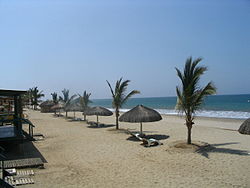Department of Tumbes
Tumbes
Departamento de Tumbes (Spanish) | |
|---|---|
 | |
 Location of the Tumbes Region in Peru | |
| Coordinates: 3°53′S 80°35′W / 3.88°S 80.59°W | |
| Country | Peru |
| Subdivisions | 3 provinces and 12 districts |
| Capital | Tumbes |
| Government | |
| • Governor | Wilmer Dios Benites (2019–2022) |
| Area | |
| • Total | 4,045.86 km2 (1,562.12 sq mi) |
| Elevation (Capital) | 7 m (23 ft) |
| Highest elevation | 134 m (440 ft) |
| Lowest elevation | 0 m (0 ft) |
| Population (2017) | |
| • Total | 224,863 |
| • Density | 56/km2 (140/sq mi) |
| UBIGEO | 24 |
| Dialing code | 072 |
| ISO 3166 code | PE-TUM |
| Principal resources | Petroleum, tobacco, bananas and fishing. |
| Poverty rate | 46.8% |
| Percentage of Peru's GDP | 0.49% |
| Website | www.regiontumbes.gob.pe |

Tumbes (Spanish pronunciation: [ˈtumbes]) is a coastal department and region in northwestern Peru bordering Ecuador. Due to the region's location near the Equator it has a warm climate, with beaches that are considered among the finest in Peru. [citation needed] Despite its small area, the region contains a wide variety of ecosystems. It is the smallest department in Peru and its third least populous department after Moquegua and Madre de Dios, but it is also its third most densely populated department, after La Libertad and Lambayeque.
The name "Tumbes" originates from either Tumpis, a group of native peoples from the area, the word tumbos, a species of Passiflora that used to abound in the area, or the name of the Tumba cacique, whose son founded and populated the area.
Geography
The Tumbes Region is bordered by the
Morphologically, four zones can be defined in the region: the delta of the Tumbes and Zarumilla rivers; an alluvial plain north of the Tumbes River, with dry, low-depth ravines; ancient terraces that have been strongly eroded in the Máncora area; and the Amotape mountain range in the east and south, ending at El Barco Mountain. The delta of the Tumbes river is shallow, and when the tide is low, little sandy keys show up, which get covered by mangrove vegetation. Despite its small area— it is the second-smallest region in Peru— Tumbes has a great variety of
Demographics
Basically composed of a large
Population
According to the
As of 2005[update], the Instituto Nacional de Estadística e Informática estimates the region's population to be 215,634.
Languages
The majority of the region's residents (98.3%) speak
Immigration
Immigrants from other regions make up 29.4% of the population; 0.2% of residents were born in a foreign country. The largest immigrant groups are from the regions of
Age
The population is spread out, with 49.4% under the age of 20, 10.7% from 20 to 24, 26.6% from 25 to 44, 9.7% from 45 to 64, and 3.5% who are 65 years of age or older.
Education
The literacy rate in the region is 90.4%.
Secondary education has been completed by 31.8% of the population and 4.5% also have graduated from non-university higher education, while 2.3% have complete university studies. 45.9% only have attended primary education and 5.9% have not had any education.[citation needed]
Political division

The region is divided into three provinces (Spanish: provincias, singular: provincia), which are composed of twelve districts (distritos, singular: distrito).
The provinces, with their capitals in parentheses, are:
History

Tumbes was a populated region well before the
Tumbes was integrated into the
The adventure of the Spanish Conquistadores had its beginning in Tumbes: at Puerto Pizarro Francisco Pizarro and his men landed in search of gold. The conquerors set off to the rest of the empire, founding cities and overpowering their people.[1]: 123
During colonial times, Tumbes was no more than a crossing point where
As part of the
Attractions
Touristic sites
The fact that Tumbes lies so close to the
South of Tumbes lies Zorritos, the town which received its name from workers involved in drilling the first oilwell in the area, back in 1863. Not far from Zorritos lies the Bocapán beach, where visitors can swim in Hervideros, natural
Typical dishes and beverages
The typical dishes of the Tumbesino cuisine are based on seafood—
.Other specialties include the shrimp omelette, chupe de cangrejos, and crabmeat omelette.
A typical beverage in the region is the chinguirito, which is obtained by combining pipa (the milk of a soft coconut) with the famous grape brandy called pisco.
References
- ^ ISBN 9781420941142
External links
- (in Spanish) Portal del Gobierno Regional de Tumbes – Tumbes Regional Government official portal
- Peru Information by Regions: Tumbes
- The Tumbesian Region, climate and endemism
- Endemic Birds of the Tumbesian Region


